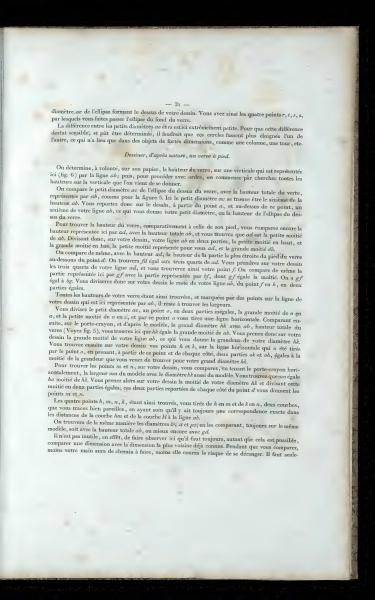Drawing from Nature, a Wine Glass.
Decide on the height of the glass on your paper, along a vertical represented here (fig. 6') by the line ab. Then, to proceed systematically, start by determining all the heights on the chosen vertical.
Compare the small diameter ae of the ellipse at the top of the glass with the total height represented by ab.
Here the small diameter ac is one-sixth of the height ab. So, indicate on the drawing, from point a upwards, one-sixth of your line ab, giving you your small diameter or the height of the ellipse at the top of the glass.
To find the height of the glass relative to its stem, again compare the height represented as ad with the total height ab. You will find that ad is half of ab. Therefore, divide ab on your drawing into two parts, with the smaller half above and the larger below. The small half represents ad and the large half db.
Similarly, compare the height ad with the narrowest part of the stem above point d. You’ll find ef equal to three-quarters of ad. Take three-quarters of your line ad from your drawing, and thus find your point f. Further compare the part represented here by gf with the part represented by bf, where gf is half, making gf equal to bg. Divide the remainder of your line ab from point f into two equal parts.
Once all heights of your glass are marked by points along the line represented here by ab, you need to find the widths.
Divide the small diameter ac at point c into unequal parts, with the larger half of n and the smaller half o at c. Through point o, draw a horizontal line. Compare again, using your pencil holder and the model, the large diameter hk to ac, the total height of the glass (Figure 5). You’ll find ac equal to half of ab. On your drawing, take half your line ab, which gives you the glass’s diameter hk. From that, find points h and k on the horizontal line drawn from o, tracing two equal segments ok and oh.
To find points m and n on your drawing, compare the width nm of the model with the diameter hk. You’ll find nm as half of the diameter hk.
Then, on your drawing, use half the diameter hk, dividing this half equally. The equal parts from each side at point d give you points m and n.
Having found points h, m, n, k, draw two curves from h to m and from k to n, ensuring exact correspondence in distances along curves hm and kn to line ab.
In the same manner, find diameters ts and pz by comparing them, either with total height ab or better with gd.
It is useful to note that dimensions should be compared with the closest known dimension whenever possible. As you compare, the less movement your hand requires, the less it risks slipping off course.
Simply
Translation Notes:
- qu'une: The word appears to be a typographical error or an older form. Interpreted as "one" to correspond with ‘half’ in modern context.
The text provides a step-by-step method for drawing a wine glass from nature, detailing how to set the glass's height and diameter on a vertical line, comparing various parts to determine proportions. It emphasizes comparing smaller parts of the glass with larger known dimensions to accurately sketch different sections, such as the glass and its stem, by using ratios and repeating these measurements across the drawing. The approach ensures precision by minimizing unnecessary hand movement and stresses the importance of comparing each dimension with the nearest known dimension.
